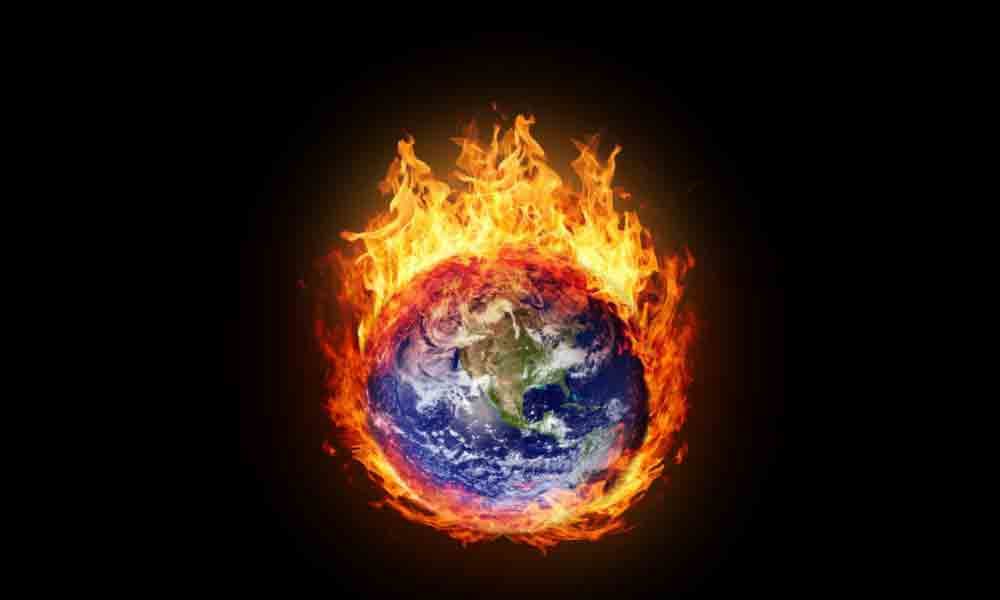Live
- Police book case against KTR for unauthorised rally
- Literature crucial in nurturing creativity
- Academicians debate on trends observed in 2024 General Elections
- Adah Sharma to perform Shiv Tandav stotram at the MahaKumbh mela
- Haryana Guv urges TG, AP CMs to implement NEP-2020
- Tail-end farmers should get irrigation water, says Uttam
- SpinSci to churn out 1K AI-based jobs in Telangana
- Kothapalli-Manoharabad rly line to be operationalised by 2027
- Industrial production at 6-mth high in Nov
- Traffic restrictions on heavy vehicles in Rachakonda
Just In
Earth warming at faster rate than in last 2,000 years: Study


Global temperatures in the 20th century are higher than ever before in at least 2,000 years, with warming now affecting the entire planet at the same time, according to a study.
Geneva (PTI): Global temperatures in the 20th century are higher than ever before in at least 2,000 years, with warming now affecting the entire planet at the same time, according to a study.
It was assumed that the "Little Ice Age" -- from about 1300 to 1850 AD -- and the similarly famous "Medieval Warm Period" were global phenomena. However, researchers at the University of Bern in Switzerland are painting a very different picture of these alleged global climate fluctuations. The research, published in the journals Nature and Nature Geoscience, shows that there is no evidence that there were uniform warm and cold periods across the globe over the last 2,000 years.
"It's true that during the Little Ice Age it was generally colder across the whole world, but not everywhere at the same time," said Raphael Neukom from the University of Bern. The peak periods of pre-industrial warm and cold periods occurred at different times in different places," said Neukom. According to the climate scientist, the now-debunked hypothesis of climate phases occurring at the same time across the globe came about because of an impression that is defined by the climate history of Europe and North America.
In the absence of data from other parts of the Earth, this notion was applied to the whole planet, raising expectations that relatively cold or warm periods throughout the last 2,000 years were globally synchronous phenomena. However, it has now been shown that this was not the case, researchers said. They see the explanation for that as being that regional climates in pre-industrial times were primarily influenced by random fluctuations within the climate systems themselves.
External factors such as volcanic eruptions or solar activity were not intense enough to cause markedly warm or cold temperatures across the whole world for decades, or even centuries. The researchers relied on a database from the international research consortium PAGES, which provides a comprehensive overview of climate data from the last 2,000 years, for their investigation of five pre-industrial climate epochs. In addition to tree rings, it also includes data from ice cores, lake sediments and corals.
To really put the results to the test, the team led by Neukom analysed these data sets using six different statistical models -- more than ever before. This allowed for the calculation of the probability of extremely warm or cold decades and centuries, and not just the calculation of absolute temperatures. The result was that no globally coherent picture emerged during the periods being investigated. "The minimum and maximum temperatures were different in different areas," said Neukom.
Thermal extremes across the world cannot be inferred from regional temperature phenomena like the oft-mentioned "Medieval Warm Period" in Europe and North America. Both studies show that the warmest period of the last 2,000 years was most likely in the 20th century. They also show that this was the case for more than 98 per cent of the surface of the Earth. This shows that modern climate change cannot be explained by random fluctuations, but by anthropogenic emissions of CO2 and other greenhouse gases.
"What we didn't know until now is that not only average global temperatures in the 20th century are higher than ever before in at least 2,000 years, but also that a warming period is now affecting the whole planet at the same time for the first time," researchers said. The speed of global warming has never been as high as it is today, they said.

© 2025 Hyderabad Media House Limited/The Hans India. All rights reserved. Powered by hocalwire.com






